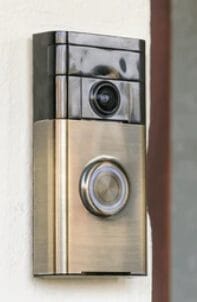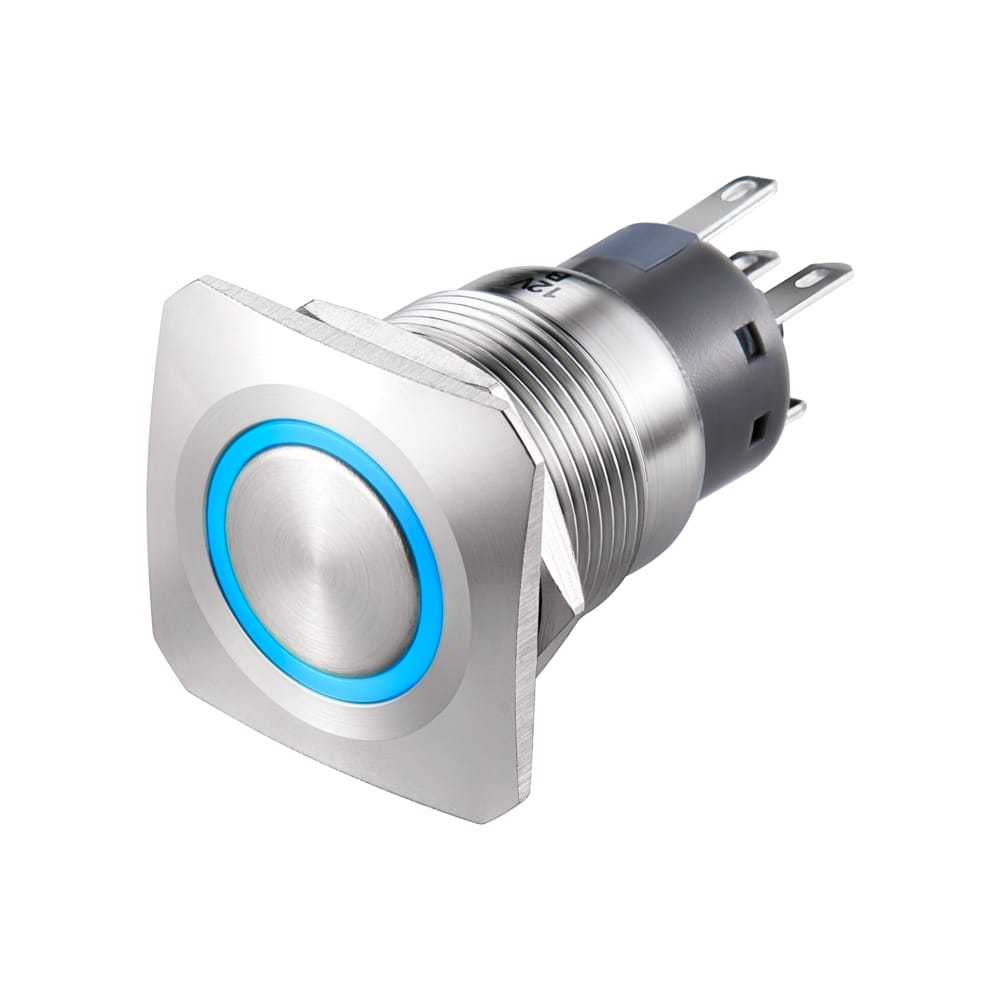Back in the 16th century, folks relied on the familiar sound of door knockers to announce their presence. Fast forward to today, and you find yourself in an age where door bell buttons have taken center stage. Doorbell buttons offer a range of benefits, enhancing both convenience and security.
No need for manual knocks – door bell buttons make announcing your arrival a breeze. Wait, there’s more! Modern door bell buttons also come equipped with features like illumination for nighttime visibility and smart options for remote monitoring through integrated cameras.
Join us as we explore the journey of this evolution and discover the practical aspects that make door bell buttons an essential feature in modern homes.
What is a Door Bell Button?
A doorbell button is a small, often decorative, device located outside a home’s entrance. When pressed, it activates the doorbell, resulting in a chiming sound that signals to occupants that someone is at the door. Door bell buttons come in various styles, from traditional mechanical buttons to modern smart buttons with additional features like cameras and connectivity.
How Do Door Bell Buttons Work?
First, let’s look at the components of door bell buttons:
- Push Button: A small button near the front door triggers a chime when pressed.
- Chime: Sounds within the home to signal someone pressed the doorbell; professional help is recommended for wiring.
- Transformer: Supplies power through the electrical system, connected via terminals.
- Terminals: Connection point for doorbell wiring and the home’s electrical system.
- Resonators: Small metal bars above and below chime terminals produce the doorbell tune.
- Solenoids: Small electromagnet that creates a magnetic field when the doorbell is pressed, causing a chime sound.
Working Mechanism
When the button is pressed, it completes the electrical circuit, allowing current to flow through a coil within the electromagnet. This generates a magnetic field, which attracts a metal rod or plunger.
As the plunger is drawn into the coil, it strikes a resonating bar or creates movement in a speaker, producing the familiar doorbell sound. This electromagnetic process is a common mechanism in traditional doorbells, emphasizing the conversion of electrical energy into mechanical movement to produce an audible alert.
How to Install a Door Bell Button?
The components you need to install a wired doorbell button are:
- Doorbell chime
- Door bell buttons
- Multimeter
- Screwdriver
- Non-contact tester
Step 1: Select Location
Choose a suitable location near the front door for installing the doorbell. Ensure proximity to an electrical source for the doorbell to draw power.
Step 2: Turn off the Power
For safety, turn off the power at the circuit breaker before starting the installation.
Step 3: Check the Transformer
Doorbell transformers convert the incoming 110V or 120V electricity to the 10V to 24V needed for the doorbell to function. To confirm the transformer’s functionality, employ a multimeter for testing.
Set the multimeter to VAC (volts AC) and place the probes on the screws securing the wires. If the reading doesn’t register (8V, 16V, or 24V), it indicates a malfunction, necessitating replacement.
Step 4: Disassemble the Current Door Bell Setup
Employ a screwdriver to detach the doorbell button from the wall. Try to disconnect the wires without resorting to cutting them, given their limited length.
Proceed to remove the cover from the doorbell chime, usually by gently snapping it off or using screws if present. Unhook the wires from the chime, and finally, loosen the mounting screws securing the chime to the wall for complete removal.
Step 5: Connect Wires to the New Doorbell Button and Chime
Install the new chime on the wall! Ensure to connect the wire originating from the transformer and the wire going from the transformer to the button.
For setups involving multiple doorbells, accurately position the wires on the terminals marked “front” or “back” based on their locations. In the case of a single doorbell, connect the transformer wire to the designated transformer terminal and the wire of the button to the other terminal.
Step 6: Restore Power and Check the Doorbell
Switch the breaker back on, restoring power. Subsequently, test the doorbell to verify the functionality and audibility of the chime.
If the doorbell fails to work, it may indicate incorrect wiring or insufficient voltage supply. In the case of continuous chiming, even without pressing the button, there could be a wiring problem or damage to the button itself.
Common Issues with door bell Buttons and How to Fix Them
Here are some common issues that you may come across with your door bell buttons requiring quick fixes:
Issue: Doorbell Not Ringing
Is your doorbell not producing any sound when the button is pressed? It could be due to various reasons, including faulty wiring or an inadequate power supply.
Solution:
- Start by checking the wiring connections at the doorbell button and chime.
- Ensure that the wires are properly attached to the correct terminals. If the wiring seems fine, use a multimeter to test the transformer’s voltage output.
- If the voltage is below the required level (8V, 16V, or 24V), consider replacing the transformer to restore proper functionality.
Issue: Continuous Chiming
Continuous chiming, even when the button is not pressed, suggests a malfunction that could be related to wiring issues or damage to the doorbell button.
Solution:
- Examine the doorbell button for visible damage or wear.
- If the button appears undamaged, inspect the wiring for potential short circuits or loose connections.
- Ensure that the wires are correctly placed on the terminals, especially in setups with multiple doorbells. If the problem persists, it may be necessary to replace the doorbell button to resolve the continuous chiming issue.
Best doorbell Button Options
It’s time to discuss the types of switches that are suitable as door bell buttons. Here are some:
Ultra Short Anti-Vandal Switch
Ultra Short Anti-Vandal Switch is a compact, robust doorbell button option that boosts reliability and durability. With panel cutouts available in 19, 22, or 25mm diameter options, this switch seamlessly integrates into various applications. It offers enhanced visibility with the optional ring illumination, adding a touch of sophistication to its design. It also withstands tough conditions, boasting an IP67 rating, ensuring resistance against dust and water.
Operating at an electrical rating of 50mA, 24VDC, our Ultra Short Anti-Vandal Switch is synonymous with efficiency. Its mechanical life of 1,000,000 cycles attests to its longevity and resilience under repeated use, while its electrical life of 50,000 cycles ensures consistent performance. The contact resistance is also minimized to 50mΩ, guaranteeing a reliable, low-resistance connection.
Key Features
- Panel cutouts in 19, 22, or 25mm diameter
- Optional ring illumination for enhanced visibility
- IP67 rated for dust and water resistance
- Option for soldered wire leads for easy installation
Square Bezel Anti-Vandal Switch
Lastly, the Square Bezel Anti-Vandal Switch is a top-tier momentary switch for doorbells with vandal-proof features. This switch stands out with its distinctive 25mm square bezel, setting it apart from standard round bezels and providing a unique aesthetic feature. With panel cutouts available in 19mm or 22mm diameter options, this switch offers versatility in integration.
Engineered with an IP65 rating, it ensures protection against dust and moisture, making it ideal for various environmental conditions. This switch also offers multiple function options, including SPDT and DPDT, catering to diverse application needs. It operates at an electrical rating of 5A, 250AC, combining robustness with efficiency.
It guarantees enduring performance with a mechanical life of 1,000,000 cycles along with an electrical life of 50,000 cycles. The contact resistance is minimized to 50mΩ, ensuring a reliable and low-resistance connection.
Key Features
- Distinctive 25mm square bezel for unique aesthetics
- Panel cutouts in 19mm or 22mm diameter options
- Optional RGB LED illumination with dot, ring, or symbol customization
- IP65 rated for dust and moisture protection
- Multiple function options: SPDT & DPDT
How to Choose Doorbell Buttons?
The following are the things you should look for when choosing doorbell buttons:
-
Select the Right Type of Door Bell Button
First things first, explore the available doorbell button options to find the best fit for your home. Traditional round buttons provide a timeless look for those who appreciate simplicity. Illuminated buttons, with built-in LED lights, offer a modern aesthetic and enhanced visibility, especially during the evening.
Touch-sensitive buttons provide a cutting-edge and sleek design, responding to a gentle touch for activation. Smart door bell buttons, integrating with advanced technologies and often featuring video monitoring, cater to tech-savvy homeowners seeking additional security and convenience.
-
Consider Compatibility
Before purchasing, ensure the doorbell button is compatible with your existing doorbell system. Check the voltage requirements and compatibility with transformers to avoid any electrical issues.
-
Material and Durability
Opt for materials that guarantee longevity and can withstand various weather conditions. Common choices include weather-resistant plastics, metals like aluminum or brass, or finishes specifically designed for outdoor use.
-
Ease of Installation
Assess the installation process. Some door bell buttons are designed for straightforward DIY installation, while others may require professional assistance. Choose one that aligns with your comfort level and technical expertise.
-
Budget Considerations
Set a budget before starting your search. Door bell buttons come in a range of price points, offering various features to accommodate different budgets. Knowing your budget helps narrow down your options and prevents overspending.
Benefits of a Door Bell Button
The benefits of installing door bell buttons in your home are:
Convenient Visitor Notification
Installing a doorbell button provides a hassle-free and universally recognized method for visitors to announce their presence. Instead of relying on manual knocks, which may go unheard or unnoticed, the doorbell button ensures a clear and audible signal that someone is at the door. This streamlines the communication process and adds a layer of convenience for both occupants and visitors.
Improved Accessibility
Door bell buttons play a crucial role in improving accessibility, particularly for individuals with mobility challenges. The simple act of pressing a button eliminates the physical effort required for knocking, making it easier for everyone to announce their arrival.
In addition, incorporating LED lights or other lighting mechanisms ensures that the button remains visible during the evening or in areas with limited natural light. This accessibility feature is essential for creating an inclusive and user-friendly home environment, catering to the diverse needs of occupants and visitors alike.
Advanced Security Features
Smart doorbell buttons with integrated cameras represent a significant advancement in home security. These buttons allow you to remotely monitor your doorstep and communicate with visitors via a connected device, such as a smartphone. The added surveillance enhances security and provides a sense of control and awareness, especially when away from home.
FAQs
What Controls a Doorbell?
The doorbell chime functions on a reduced voltage supplied by the transformer. The transformer transforms the standard electrical voltage, typically around 110-120 volts, down to an approximate range of 10-24 volts.
Is Doorbell a Switch?
A doorbell button operates as a momentary power button, similar to many computer power switches. When pressed, it momentarily completes an electrical circuit, activating the doorbell system and producing the chime or sound.
Does a Doorbell Use Low Voltage AC or DC?
A doorbell commonly operates on low-voltage AC (alternating current), usually transformed from the standard household voltage of 110-120 volts to a lower range of 10-24 volts by a transformer. This lower voltage ensures safety during operation. Unlike some electronic devices that may use DC, doorbells traditionally rely on the rhythmic flow of AC for their functioning.
Does a Door Bell Work with a Battery?
Doorbells typically do not rely solely on batteries for power; instead, they are commonly wired to the home’s electrical system. However, some modern doorbell models, such as wireless or smart doorbells, may incorporate battery-powered components for added flexibility. These battery-powered options are for easy installation and can be suitable when wiring is challenging or unavailable.
Conclusion
From their origins as door knockers in the 16th century to the present-day smart options, door bell buttons have evolved into essential components of modern homes. Understanding their low-voltage operation, intricate components, and diverse types allows you to make informed choices based on your specific needs and preferences.
The benefits of doorbell buttons extend beyond mere convenience, encompassing enhanced security and inclusivity for individuals with mobility challenges.
In addition, the vast array of choices, from classic designs to smart features, underscores the adaptability of these devices to diverse home styles and technological preferences. In case you are looking for high-quality doorbell buttons, Langir has you covered. Get in touch with us now and grab your favorite doorbell buttons to enhance the security of your home.
Send your inquiry now
All Langier News:
Read Moreelectronica 2024 Hall-Stand No.: A2 160 November 12-15, 2024 Tr...

 English
English 简体中文
简体中文







